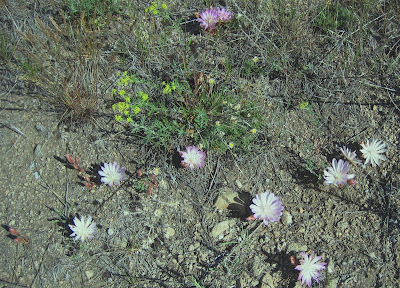
Here is a photo of Silver Bow Creek before clean-up:

Note the large, barren areas. The barren areas are phytotoxic mine tailings. Few organisims could survive in the polluted creek.
Here is a photo of Silver Bow Creek during an early phase of clean-up and reconstruction (c. 2000):

Enormous amounts of toxic material were hauled away. The stream channel was rebuilt to mimic a form that might have been there 150 years ago when placer mining turned the entire riparian zone upside-down. The banks and riparian zone were revegetated with native species.
I decided to float the Silver Bow Creek of today:

RTD and I put a few miles downstream of Butte, and intended to float to the Gregson/Fairmount area. Here's RTD riding tall in the parrot seat:

Throughout our float, we saw many ducks (mostly mallards), lots of redwing blackbirds and various "little brown birds," one great blue heron, a huge mayfly hatch (between Rocker and Ramsay), and a large (50 to 100 fish) school of suckers in every pool. Compared with the lifeless creek of a few years ago, not bad!

The new vegetation has really benefitted by the cool, wet spring this year, as shown by the lush banks:

Weeds are generally absent, though there was the occasional patch of dalmation toadflax (a noxious, if beautiful, invasive species) [maybe NOT dalmation toadflax--see Matt Vincent's comment]:

On wonders why the stream engineers created these "diving board" structures:

Perhaps they would have served some function if the baseflow of the creek doubled or tripled?
For the most part, the channel was clear of obstructions for my somewhat fragile, inflatable Sevylor "Tahiti boat." There were a few bridges of various sorts, ranging from the I-15 overpass:

To more rural roads with culverts like this one:

There are a few hazards in the form of sweepers as you approach the Ramsay area. Why the hell the engineers designed these log-footbridge hazards is beyond me. No problem in low water, though they are a pain in the ass since you need to portage around them. In high water, you could get in trouble fast:

Here's the Rarus Railroad tour train, the Copper King Express, passing by:

Even though I took the precaution of walking the Tahiti boat through the culverts and spillways at bridge crossings, I caught the bottom on a snag and tore a hole. Though the boat still floated well, it was low in the water and not much fun. So I decided to take out at the town of Ramsay, near this great old stone building (it really defines the meaning of bricolage!):

The Tahiti boat is undergoing a three-layered repair and is down for a day or two. Before the water gets too low, I am looking forward to floating the rest of the trip: the recently remediated and still-undergoing-restoration Ramsay Flats and the scenic and wild Durant Canyon.






































